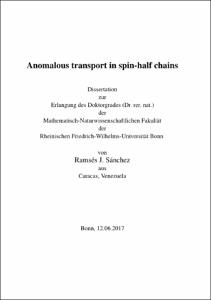Sánchez, Ramsés J.: Anomalous transport in spin-half chains. - Bonn, 2018. - Dissertation, Rheinische Friedrich-Wilhelms-Universität Bonn.
Online-Ausgabe in bonndoc: https://nbn-resolving.org/urn:nbn:de:hbz:5n-51565
Online-Ausgabe in bonndoc: https://nbn-resolving.org/urn:nbn:de:hbz:5n-51565
@phdthesis{handle:20.500.11811/7612,
urn: https://nbn-resolving.org/urn:nbn:de:hbz:5n-51565,
author = {{Ramsés J. Sánchez}},
title = {Anomalous transport in spin-half chains},
school = {Rheinische Friedrich-Wilhelms-Universität Bonn},
year = 2018,
month = aug,
note = {We study quantum spin transport in clean anisotropic spin-half chains, at and away from integrability. Using exact diagonalization, a set of exact sum-rule moment relations and a memory function Ansatz we investigate the response of the XXZ model to next nearest-neighbor integrability breaking spin flips, both at zero and infinite temperatures. Depending on the sign of the perturbation the model can display in-plane frustration in its ground state which localizes the spin degrees of freedom. In the zero temperature limit we compute the spin stiffness (or superfluid density) using exact diagonalization and find an interaction-induced enhancement of the spin stiffness due to the competition between spin-dimer and Neel-like configurations --- the former favored by frustration, the latter by the spin anisotropy. In the infinite temperature limit we analyze two quantities: the spin stiffness and the regular Kubo conductivity. The former vanishes in nonintegrable systems and thus we consider it only in the XXZ model. Using exact diagonalization we find the stiffness vanishes exactly due to spin-inversion symmetry in a canonical ensemble calculation, for all but the commensurate set of anisotropies at which the system shows the so-called sl-2 quantum loop symmetry. Hence spin transport is ballistic within the gapless phase of the XXZ chain. At the isotropic point and within the gapped phase the stiffness is found to vanish in the thermodynamic limit, independent of symmetry or ensemble. Our analysis demonstrates how convergence to the thermodynamic limit within the gapless phase may be accelerated: the spin stiffness extrapolates nicely in the thermodynamic limit to either the recently computed exact lower-bound or the Thermodynamic Bethe Ansatz result provided both spin-inversion and sl-2 loop symmetry are broken. To study AC response we use a set of exact sum-rule moment relations together with a memory function Ansatz which describes the regular Kubo conductivity in the long-wavelength limit. We find in the XXZ model: (i) superdiffusion at the isotropic point, with a power-law frequency dependent conductivity whose exponent agrees closely with recent t-DMRG computations; (ii) subleading subballistic behavior in the regular component of the conductivity within the gapless phase; and (iii) normal diffusion deep into the gapped phase, with a diffusion constant linearly proportional to the weak hopping. We further find the sign of the integrability breaking perturbation matters: while positive spin-flips (in-plane frustration in the ground state) enhance spin transport, there is a narrow interval of negative spin-flips amplitudes for which transport is strongly suppressed. The resulting (anomalous) long-time transport tails as inferred from the regular conductivity of small spin chains (computed using exact diagonalization) are captured faithfully, qualitatively and quantitatively by the memory function Ansatz in all regimes: gapless, isotropic, and gapped for the integrable chain, as well as across vast parametric swathes of the nonintegrable chain.},
url = {https://hdl.handle.net/20.500.11811/7612}
}
urn: https://nbn-resolving.org/urn:nbn:de:hbz:5n-51565,
author = {{Ramsés J. Sánchez}},
title = {Anomalous transport in spin-half chains},
school = {Rheinische Friedrich-Wilhelms-Universität Bonn},
year = 2018,
month = aug,
note = {We study quantum spin transport in clean anisotropic spin-half chains, at and away from integrability. Using exact diagonalization, a set of exact sum-rule moment relations and a memory function Ansatz we investigate the response of the XXZ model to next nearest-neighbor integrability breaking spin flips, both at zero and infinite temperatures. Depending on the sign of the perturbation the model can display in-plane frustration in its ground state which localizes the spin degrees of freedom. In the zero temperature limit we compute the spin stiffness (or superfluid density) using exact diagonalization and find an interaction-induced enhancement of the spin stiffness due to the competition between spin-dimer and Neel-like configurations --- the former favored by frustration, the latter by the spin anisotropy. In the infinite temperature limit we analyze two quantities: the spin stiffness and the regular Kubo conductivity. The former vanishes in nonintegrable systems and thus we consider it only in the XXZ model. Using exact diagonalization we find the stiffness vanishes exactly due to spin-inversion symmetry in a canonical ensemble calculation, for all but the commensurate set of anisotropies at which the system shows the so-called sl-2 quantum loop symmetry. Hence spin transport is ballistic within the gapless phase of the XXZ chain. At the isotropic point and within the gapped phase the stiffness is found to vanish in the thermodynamic limit, independent of symmetry or ensemble. Our analysis demonstrates how convergence to the thermodynamic limit within the gapless phase may be accelerated: the spin stiffness extrapolates nicely in the thermodynamic limit to either the recently computed exact lower-bound or the Thermodynamic Bethe Ansatz result provided both spin-inversion and sl-2 loop symmetry are broken. To study AC response we use a set of exact sum-rule moment relations together with a memory function Ansatz which describes the regular Kubo conductivity in the long-wavelength limit. We find in the XXZ model: (i) superdiffusion at the isotropic point, with a power-law frequency dependent conductivity whose exponent agrees closely with recent t-DMRG computations; (ii) subleading subballistic behavior in the regular component of the conductivity within the gapless phase; and (iii) normal diffusion deep into the gapped phase, with a diffusion constant linearly proportional to the weak hopping. We further find the sign of the integrability breaking perturbation matters: while positive spin-flips (in-plane frustration in the ground state) enhance spin transport, there is a narrow interval of negative spin-flips amplitudes for which transport is strongly suppressed. The resulting (anomalous) long-time transport tails as inferred from the regular conductivity of small spin chains (computed using exact diagonalization) are captured faithfully, qualitatively and quantitatively by the memory function Ansatz in all regimes: gapless, isotropic, and gapped for the integrable chain, as well as across vast parametric swathes of the nonintegrable chain.},
url = {https://hdl.handle.net/20.500.11811/7612}
}






